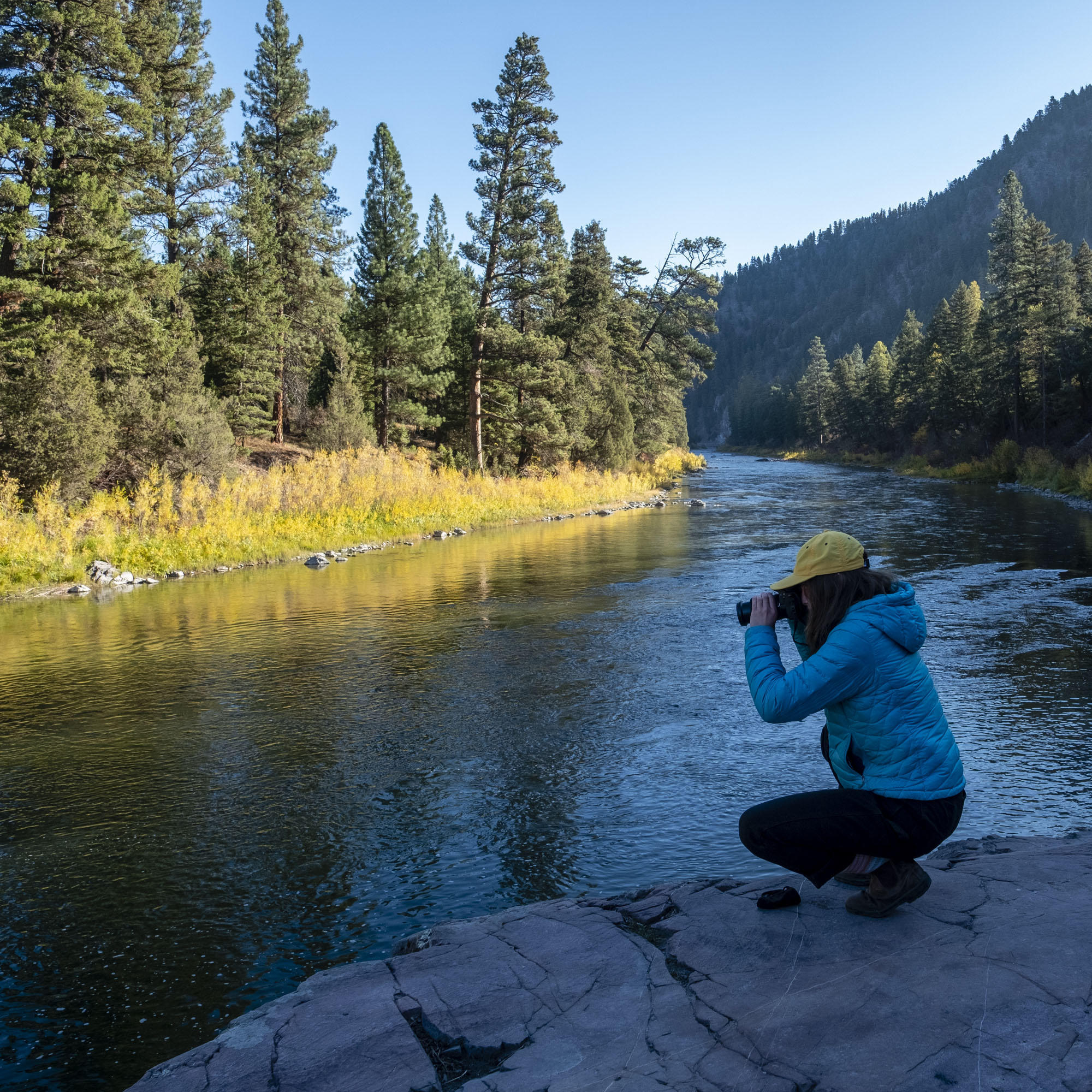Geoff McGhee
Geoff McGhee, T. Anthony Pollner Distinguished Professor, Spring 2021
 Geoff McGhee is an infographics and multimedia journalist whose work spans the mass media and academic worlds. He is a veteran of The New York Times, ABC News and France’s Le Monde, and he spent nine years working at Stanford University creating original journalism, interactive graphics and dashboards exploring contemporary and historical topics around the North American West. In addition to working with such clients as Schema Design, The Committee to Protect Journalists and the Oxford University Press, among others, Geoff serves as the visuals editor for the Water Desk at the University of Colorado, Boulder, and the Associate Editor of “... & the West,” a digital publication covering western environmental and public health issues. In 2009-10, Geoff was a Knight Fellowship at Stanford researching data visualization, which resulted in the widely-cited video documentary “Journalism in the Age of Data.” In 2015-16 he was the lead writer on National Geographic’s “Data Points” blog. At UM in 2021, Geoff helped advise the Montana Kaimin and taught a seminar, “The Infographic Story,” which led students through the process of reporting and producing a data-driven visual feature story.
Geoff McGhee is an infographics and multimedia journalist whose work spans the mass media and academic worlds. He is a veteran of The New York Times, ABC News and France’s Le Monde, and he spent nine years working at Stanford University creating original journalism, interactive graphics and dashboards exploring contemporary and historical topics around the North American West. In addition to working with such clients as Schema Design, The Committee to Protect Journalists and the Oxford University Press, among others, Geoff serves as the visuals editor for the Water Desk at the University of Colorado, Boulder, and the Associate Editor of “... & the West,” a digital publication covering western environmental and public health issues. In 2009-10, Geoff was a Knight Fellowship at Stanford researching data visualization, which resulted in the widely-cited video documentary “Journalism in the Age of Data.” In 2015-16 he was the lead writer on National Geographic’s “Data Points” blog. At UM in 2021, Geoff helped advise the Montana Kaimin and taught a seminar, “The Infographic Story,” which led students through the process of reporting and producing a data-driven visual feature story.
Reflections:
 City limits
City limits
Hiking up a fire trail on Mount Sentinel around dusk in late April, my goal was finally within reach. A line of evergreen trees near the top formed a triangle dropping into the grassy hillside where deer graze and paragliders launch themselves on clear days. I'd seen it from the upstairs window since arriving in January, but the way up had always been blocked by a fence, now removed.
The freedom to climb up the hillsides and gaze down at the city is one of the delights of Missoula. All long-distance views, in my view, trigger Big Thoughts about the future. What did I see as the sky turned red and the lights came up across the valley? The airport runway, lined up in near-perfect orientation but still off to the northwest. Would it become choked with tourist planes and private jets in due time? Maybe not, Missoula is still good and funky and lacking an elite-level resort. Let the swells go to Glacier and Bozeman.
An emerging Zoom town, Missoula was boiling with change in the pandemic era. In my class, The Infographic Story, we explored how the pending 2020 Census results would change the landscape, and how the changing landscape would affect the Census. Looking West toward the Boot Barn on Brooks, I visualized the ring of transition where solidly Democratic voting precincts eased into the familiar red of the rest of the state. Montana was slated to regain its lost second Congressional seat – setting up a very interesting redistricting opportunity for the state's new Republican-dominated government.

Graphic from a lab in The Infographic Story
Yet Missoula, for all its growth into the valley, was on the verge of "relegation," to use the term familiarized by the soccer comedy Ted Lasso. Analysts at the Census bureau were finalizing plans to raise the threshold of "Metropolitan" areas to 100,000 residents and above. This would send Missoula and scores of cities, many of them western county seats and college towns, below the threshold of eligibility for federal programs like those supporting the surprisingly nifty Mountain Lion bus system.
Which way, Missoula? Could increased growth go hand-in-hand with more housing and affordability for locals who are increasingly priced out? Personally, I think the Census rule would provide a long-missing counterbalance to Nimbyist resistance to increased density. Might “up or out” motivate leaders to embrace more permissive housing rules?
Pandemic academic

Graphic exercise from a lab in the Infographic Story class
Arriving at the peak of the pandemic, for some time I had to ponder these questions on my own. As the restrictions eased and classrooms reopened, I delighted in getting to know my colleagues along the fourth floor hallway. My visual journalist neighbors Keith Graham and Jeremy Lurgio. Joe Eaton and his marvelous vintage car; Dennis Swibold and I figured out how to turn 10 year old office iMacs into gorgeous second displays. Lee and Jule Banville lent me a mountain bike to help me zip around without a car. Nate Rott was a fun presence between trips home to LA.
Suggestion mode
After we got vaccine pokes in March, I was overjoyed to finally spend some time in the Kaimin newsroom. Going from virtual to physical was a disorienting experience, somewhat like the Wizard of Oz turning to color. It must have been weird for the student journalists to be co-advised by the Man Behind the Curtain, but they were good sports about my enthusiastic use of Google Docs “suggestion” mode (juuuust a suggestion!!) and my exhaustingly thorough issue critiques. Thank you, Erin Sargent, Addie Slanger, features editor Alex Miller and all the Kaimin team! And Jason Begay, my co-adviser who helped me in countless ways.
Working on a real-live newspaper for the first time in a while was a thrill. I loved reading the hard copy and the juxtaposition of layout, text and visuals that I've tried for decades to match in digital space with halting success. I was impressed at how resilient the Kaimin staff were when the Missoulian shut down its press and we had to wait an extra day for copies to arrive from Helena instead.
It was also a banner time for explanatory journalism, as the legislature took full advantage of a GOP governorship to flood the zone with culture-war bills taking aim at abortion access; hunting restrictions on Indigenous land; restrictions on juvenile gender transition and athletic participation; and of course the law passed in February that would permit handguns on state university campuses like UM. Mariah Thomas was a stalwart at the sometimes-thankless job of covering these bills’ journeys through the process and untangling their sometimes veiled import to students whose first interest might not be state government.
The guns-on-campus law seemed like a can of gasoline thrown on a student body already rattled by Covid health worries and the consequent social isolation. The Kaiminers and my 13 students persevered through it all, and it gave me such comfort to see their bright faces in my Zoom grid week after week.
The depopulated campus and quiet streets of Missoula sometimes carried a whiff of post-apocalyptic danger. But sometimes it’s the thing you're not worrying about that gets you.
Up on Mount Sentinel, as I began to wonder if it wasn't time to head back down, my phone lit up with an update from UM campus safety: “Bear encounter on the M trail.” In other words, about halfway down the mountain from where I stood, darkness falling around me.
Which brings us to that other trigger of Big Thoughts – when we sense mortal danger. What would I want to say if I was almost out of time? To my family back in Seattle, that I love them and missed them; to Denise Dowling, the UM journalism school and the Pollner family: thank you for this wonderful opportunity, whose memory will live with me for years; to my predecessor, E. Tammy Kim: thanks for helping me prepare for life in Missoula!; to my students and my Kaimin colleagues: thank you for giving me the chance to practice mentoring you. You impressed me so much. I am so excited for your futures, and eager to watch you help our industry evolve and thrive.
And I’m so glad to have avoided the bear and stayed out of the Kaimin’s police blotter. Go, Griz!
